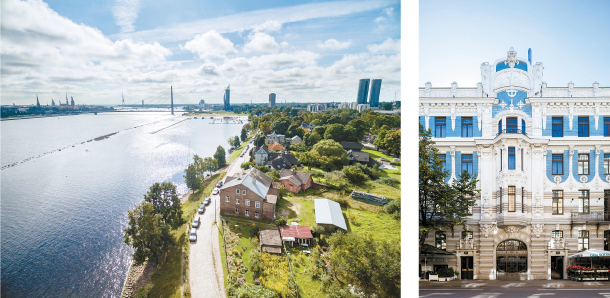Architecture reveals Latvian history

“Latvia: Architecture at Convergence” features photos of Latvian architecture and cityscapes, left. “Art Nouveau Apartments and Retail Premises,” right, showcases Latvian Art Nouveau style, noted for its contrasting colors. [KOREA FOUNDATION, A+U]
In an effort to tackle that question, at least in the realm of architecture, the Embassy of the Republic of Latvia and the Korea Foundation are now hosting “Latvia: Architecture at Convergence” at the Korea Foundation’s KF Gallery in central Seoul.
Featuring 40 photographs, three short documentaries, plus books and magazines, the exhibition showcases the wide range of styles found in Latvia’s architecture, which reflects the diverse civilizations and cultures the country has come in contact with throughout its history.
On display are photographs of St. Peter’s Church, a Gothic-inspired structure believed to have been built as early as A.D. 1209, and examples of Art Nouveau, a style of architecture popular in the early 1900s characterized by vivid contrasting colors like porcelain white and pale blue.
The Daugava - a river that runs through the capital city of Riga - is prominently featured in many of the photographs on display, its beauty blending in nicely with surrounding lush green meadows. Wooden houses dot the riverside, a testament to a widespread desire in the country to escape the urban rush.
Crossroads are the central theme running through the exhibit. Situated between the Baltic Sea to the west and bordering Russia to the east, Latvia has often found itself home to vibrant geographical, political, commercial and social exchanges.
Latvia’s first exposure to western Europe came with the arrival of the Crusaders in the late-12th century. In the following centuries, Latvia was molded by influences of stronger neighboring powers - like Russia, Germany, Poland and Sweden - all the while trying to keep its own culture and tradition alive.
Although the Republic of Latvia was established in 1918, the country fell under Soviet rule in the second half of the 20th century and only recently declared independence again in 1991.
At “Architecture at Convergence,” visitors will be able to get insight not only into Latvian history and architecture but also into customs and society. One of the photographs depicts the Latvian Song and Dance Festival Heritage, an event held every five years that has brought Latvians together since 1873.
A wall of the exhibition also offers a handy timeline that highlights architectural milestones in both Korea and Latvia through the centuries to help visitors better contextualize Latvian history. Graphs and statistics comparing population sizes and density of Seoul and Riga are also available.
The exhibition was previously held in several cities in Japan. The idea for the exhibition originates from the Japanese magazine “a+u” (Architecture and Urbanism), which published a special issue titled “Latvia-Architecture Unfolding” in December 2016. Ilze Paklone, a Latvian architect who attended the launch of the exhibition in Seoul, served as guest editor for the issue.
BY KIM EUN-JIN [kim.eunjin1@joongang.co.kr]
The exhibition runs through June 12. The KF Gallery is open from 10 a.m. to 7 p.m. Monday through Friday, and until 4 p.m. on Saturdays.
Entry is free. Contact (02) 2151-6520 for or go to https://www.facebook.com/kfglobalcenter for more information.










with the Korea JoongAng Daily
To write comments, please log in to one of the accounts.
Standards Board Policy (0/250자)